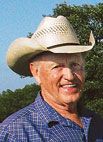
Along a stretch of Ozarks highway, just west of Lebanon, Mo., a small herd of beautiful Texas Longhorn cattle graze in a summer-green field filled with wild flowers, tempting any amateur photographer to stop and capture a scene that speaks of the Texas prairie 100 years ago.
Jack D. Glendenning of Laclede County, has until most recently, been a long time Limousin man, but that did not stop him from trying something new. “I was looking for a way to expand in the cattle business that wasn’t going to be real expensive,” he admitted candidly. “I’ve got a lot of money tied up in the 100 head of Limousin cattle we already have so when I found I could buy Texas Longhorns at a reasonable price, I thought, why not? Everything is so high right now and I found these in the newspaper,” he added with a laugh.
“I’ve been really surprised by these animals,” he explained while strolling through the high grass of the 150 acres of rented pasture where he currently has 27 Longhorn heifers, calves and bulls. “They are like big babies but you have to watch out for those horns because they don’t,” he continued, as he stuck out his hand to fend off one of the momma cows two foot longhorns as she approached. Jack and his son, Jase, age 17, stood outside their truck to hand feed the gathered cows, that clearly preferred to eat from their hands rather than settle for the pellets that fell to the ground.
“They’ll eat just about anything and we’ve fed very little hay or other supplemental feed,” he continued. “They’re almost like goats, in that they’ll eat anything and especially lots of grass. They’re doing really well and I may get more. These heifers were bred when I got them so now we have more Long Horn calves as well.
“The other reason I got into this has to do with the fact that I’m in my fifth year, my second term on the board of the North American Limousin Foundation, out of Denver, Colo. Recently, folks from Straus Veal came to us, looking for another source for their veal and lamb so my goal here is to breed our Limousin bulls with Longhorn heifers to see if we can’t qualify for that market. The calves have to be half Limousin to qualify so we’ll be using homozygous polled Red Limousin bulls, which will produce calves with no horns. Handling is the real issue with these animals because of those horns and the cattle don’t pay any attention to them at all. Our plan is to raise solid red calves and put more meat, more muscle on them with cross-breeding with the Limousins.”
Jase helps his dad with the cattle as well as in their family business. He and his brother, Josh, who will be a freshman at University of Missouri this fall and his little sister, Jamye, an eighth grader and his mother, Vicky run the Sand Spring Motel and Restaurant at Bennett Spring. Jase will be a senior at Lebanon High School this fall and he admitted at first, he was not so sure about this new breed of cattle. “I like them now and I think they’ll do good.”
“Every now and then a college educated cattleman has to try something different,” Jack, who holds a Masters in Animal Science from University of Central Missouri in Warrensburg, concluded with a smile. “I’m having fun with these but it’s also a study. And if it doesn’t work out, it’s all right because a lot of my friends are already convinced, I’m just plain crazy.”







